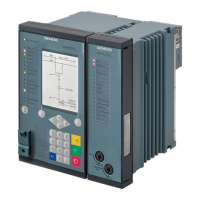²
Start the synchronization stage, for example, externally with binary input signal or via the integrated
controller. You can use a synchroscope to trigger the start at synchronism, that is, at 12 hours. The dura-
tion until the close command then corresponds to a cycle with the duration 1/Δf. At a frequency differ-
ence of 0.1 Hz, the duration is thus 10 s.
²
Insofar as permissible, perform this attempt several time for oversynchronous switching and subsynchro-
nous switching.
²
The switching performance can be checked with an external recorder or the integrated fault recording
function. You have to start the fault recording explicitly.
²
You can repeat the blind switching attempts at the limits of the permissible voltage difference.
b) Attempt with synchronous systems:
²
Start the synchronization stage, for example, externally with binary input signal or via the integrated
controller.
²
Check the proper release for activation with the message log or via a fault record. You have to start the
fault recording explicitly. All activation conditions have to be fulfilled within the time Delay close
command.
If you observe the change between synchronous and asynchronous operation, raise the changeover
threshold f-threshold ASYN<->SYN slightly.
c) Attempt with synchrocheck:
²
If you use this function in conjunction with the manual synchronization, check the proper release for
closure.
²
Synchronize the generator manually. Start the synchronization stage externally via a binary input. Check
the proper release for closure with the indicatiion log or via the fault record. You have to start the fault
recording explicitly.
Functional Tests
10.2 Primary and Secondary Testing of the Synchronization Function
1062 SIPROTEC 5, High-Voltage Bay Controller, Manual
C53000-G5040-C015-9, Edition 11.2017

